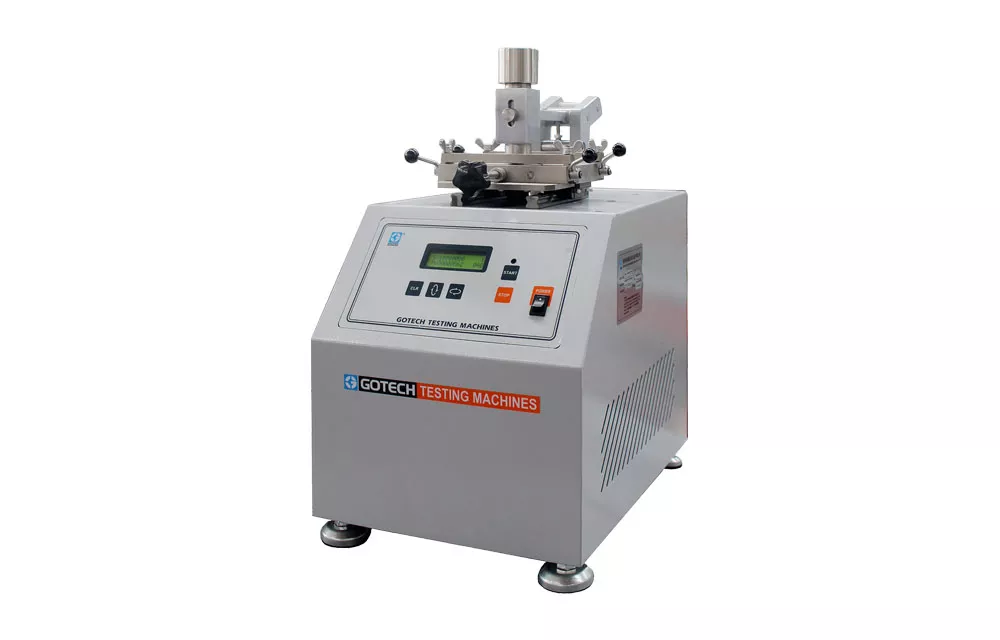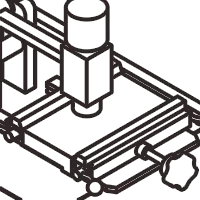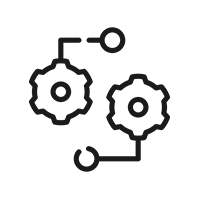
- The GT-7034-ES is specifically designed to assess the colorfastness of leather, plastics, and textiles.
- To evaluate the colorfastness, the specimen is rubbed with a piece of wool felt under a specific pressure and reciprocating motion on this instrument.
-
Standards
- SATRA TM173
- QB/T 2537-2001
- ISO 11640-2018
- QB/T 2882-2007
- ISO 17700-2019
- BS EN 13516-2002
PRINCIPLE
The specimen is rubbed with a piece of wool felt under a specific pressure and reciprocating motion on this instrument. After a specified number of cycles is reached, assess the change in color of the specimen and the staining of the wool felt using grey scales.
Wide material applications:
The IULTCS rub fastness tester is well-suited for assessing the colorfastness of leather, plastics, and textiles resulting from rubbing.
Reciprocating rubbing method:
Utilizes a piece of wool felt in reciprocating motion to rub the specimen, simulating real-world rubbing scenarios.
Fixed pressure:
Applies a prescribed pressure consistently to the specimens during the reciprocating rubbing to form a standardized test procedure and ensure results comparability.
Adjustable test cycles:
Allows operators to set and adjust the number of rubbing cycles to simulate wearing in real-world scenarios
Colorfastness assessment:
Enables operators to compare the change in color of the specimen and the staining of the wool felts using grey scales, ensuring consistency in assessments of both color change and staining.
Standard conformity:
Ensures that products meet industry standards and satisfy quality expectations in the market.
-

Single-station design
Provides simplified setup and straightforward operation, enabling operators to conduct colorfastness tests easily.

Multi-functional
Capable of performing either dry or wet colorfastness tests.

Intuitive interface
The intuitive and easy-to-use interface allows operators to quickly learn how to operate the instrument.
-
 左右滑動看表格
左右滑動看表格
*Product design and specifications are subject to change without notice.Test station 1 Stroke 36mm Space between specimen grips 80mm Extension rate 1% to 20% (adjustable) Mass of weight QB/T2882-2007 4.9±0.1N;9.8±0.2N ISO 17700-2019 BS EN 13516-2002 SATRA TM173 QB/T2537-2001 500g±10g;1000g±20g ISO 11640-2018 Cavity of finger 15×15 mm, Depth of 3.9mm±0.1mm Rubbing speed 40±2 rpm Counter LCD 0 to 99,999,999 Dimensions (W×D×H) 28×48×54 cm Power 1∮ AC 220V 50/60Hz 120W(or specify)
-
-
Details
Standards
- SATRA TM173
- QB/T 2537-2001
- ISO 11640-2018
- QB/T 2882-2007
- ISO 17700-2019
- BS EN 13516-2002
PRINCIPLE
The specimen is rubbed with a piece of wool felt under a specific pressure and reciprocating motion on this instrument. After a specified number of cycles is reached, assess the change in color of the specimen and the staining of the wool felt using grey scales.
Wide material applications:
The IULTCS rub fastness tester is well-suited for assessing the colorfastness of leather, plastics, and textiles resulting from rubbing.
Reciprocating rubbing method:
Utilizes a piece of wool felt in reciprocating motion to rub the specimen, simulating real-world rubbing scenarios.
Fixed pressure:
Applies a prescribed pressure consistently to the specimens during the reciprocating rubbing to form a standardized test procedure and ensure results comparability.
Adjustable test cycles:
Allows operators to set and adjust the number of rubbing cycles to simulate wearing in real-world scenarios
Colorfastness assessment:
Enables operators to compare the change in color of the specimen and the staining of the wool felts using grey scales, ensuring consistency in assessments of both color change and staining.
Standard conformity:
Ensures that products meet industry standards and satisfy quality expectations in the market.
-
Features

Single-station design
Provides simplified setup and straightforward operation, enabling operators to conduct colorfastness tests easily.

Multi-functional
Capable of performing either dry or wet colorfastness tests.

Intuitive interface
The intuitive and easy-to-use interface allows operators to quickly learn how to operate the instrument.
-
Specifications
 左右滑動看表格
左右滑動看表格
*Product design and specifications are subject to change without notice.Test station 1 Stroke 36mm Space between specimen grips 80mm Extension rate 1% to 20% (adjustable) Mass of weight QB/T2882-2007 4.9±0.1N;9.8±0.2N ISO 17700-2019 BS EN 13516-2002 SATRA TM173 QB/T2537-2001 500g±10g;1000g±20g ISO 11640-2018 Cavity of finger 15×15 mm, Depth of 3.9mm±0.1mm Rubbing speed 40±2 rpm Counter LCD 0 to 99,999,999 Dimensions (W×D×H) 28×48×54 cm Power 1∮ AC 220V 50/60Hz 120W(or specify)
-
Video

